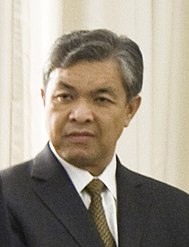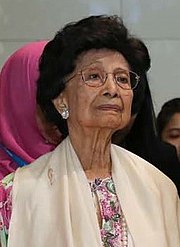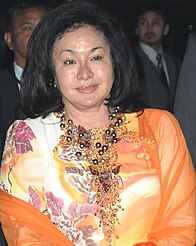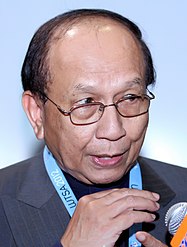Indonesian Malaysians
| Total population | |
|---|---|
| More than 50% Malaysian Malays[1][2] | |
| Regions with significant populations | |
| Nationwide | |
| Languages | |
| Predominantly Malay (Standard Malaysian)
| |
| Religion | |
| Predominantly Sunni Islam | |
| Related ethnic groups | |
Indonesian diaspora
|
The Indonesian Malaysians, also known as Anak Dagang (Malay/Indonesian: Orang Malaysia Keturunan Indonesia) are Malaysian citizens of Indonesian ancestry. Today, there are many Malaysian Malays who have lineage from the Indonesian archipelago and have played an important role in the history and contributed to the development of Malaysia, they have been assimilated with other Malay communities and are grouped as part of the foreign Malays or anak dagang in terms of race. The Malaysian census does not categorize ethnic groups from the Indonesian archipelago as a separate ethnic group, but rather as Malays.[3] In Malaysia, the definition of Malay is a person who can speak Malay, is Muslim, and follows Malay traditions and customs, even non-natives who marry Malays and embrace Islam are also accepted as Malays. In Malaysia there is a political trend of trying to put all ethnic groups who speak Malay and happen to be Muslim under one banner - Malay ("If you speak Malay and you are Muslim, then you are Malay"). This is not the case in Indonesia where all ethnic groups have their own cultural identities that are recognized and respected by the government.[4][5][1]
Several ethnic groups of Indonesian origin such as Acehnese, Minangkabau, Javanese, Banjarese, Mandailing[6] and Bugis have significant migration to Malaysia and form significant communities in Malaysia.[7] Negeri Sembilan, in particular, has large numbers of Minangkabau, Acehnese in Kedah, Javanese in Johor, Banjar in Perak and Bugis in Selangor and Sabah. There are 3 kings and 6 prime ministers of Malaysia who also have ethnic lineage from the Indonesian archipelago, such as the kings of Johor and Selangor who have Bugis lineages, and Raja Negeri Sembilan who have Minangkabau lineages. Malaysia's former first prime ministers Tunku Abdul Rahman,[8] Najib Razak, and Muhyiddin Yassin, each of them have Minangkabau, Bugis and Javanese ancestry.[9][10]
History[]
The history of Indonesia and history of Malaysia were often intertwined. Throughout their history, the borders of ancient kingdoms and empires – such as Srivijaya, Majapahit, Malacca and Johor-Riau – often comprised both modern-day countries. For centuries, the relations, migrations, and interactions between Indonesian and Malaysian people have been quite intense, and it is common for Malaysians to trace their relatives in Indonesia and vice versa.
The migration of Indonesian to Malaysia can be traced back since before the colonial time especially during the Srivijaya and Majapahit administration. The first king of the Malacca Sultanate was descended from the Srivijaya prince Sang Nila Utama from Palembang. Interracial marriages between Sultanates such as between Sultan Mansur Shah of Malacca and the Princess Raden Galuh Chandra Kirana of Majapahit are stated in the Malay Annals.[11] Other historical texts such as Tuhfat al-Nafis (known as Sejarah Melayu dan Bugis (History of the Malays and Bugis)), stated the relations between different Sultanates of Johor-Riau, Kedah, Perak, Selangor, Pahang, and Terengganu on the peninsula with the east and west coasts of Sumatra and Kalimantan.[11]
During the British occupation, Malaysia was integrated into the world's commodity and capital markets, became a source of resources for the colonizers (suzerain) and began to face labor shortages. Britain then looked for sources of labor from countries such as India and China. Indonesians became the third source of labor and the British viewed and treated them differently from Indians and Chinese because they were considered to have the same race as Malays.[12]
Post-decolonization, the government, like other political institutions in a democracy, tries to maintain its mandate and legitimacy through elections. This has implications for providing incentives and broadening the support base. By classifying Indonesian migrants (such as Javanese, Minangkabau, Bugis, Bawean, Banjar, Mandailing, Acehnese and others) into ethnic Malays, the government party Pertubuhan Kebangsaan Melayu Bersatu or UMNO expanded its mass base. The reason for the classification and the criteria for ethnic Malays in the Malaysian constitution is a socio-historical construction. This historical aspect exists because the identity defined in the Malaysian constitution has existed since the time of the Malacca sultanate in contrast to the Orang Asli or the Dayak people. So that anyone who meets the socio-religious requirements of the Malays is classified as a Malay (ethnic group).
Population[]
Minangkabau[]
The Minangkabau Malaysians are people of full or partial Minangkabau descent who were born in or immigrated to Malaysia. They form a significant part of Malaysia's population and Malaysian law considers most of them to be Malays. Minangkabau people originate from West Sumatra, Minangkabau have a long history of migration to Malaysia. Minangkabau people dominate in Negeri Sembilan, both in terms of population and culture. At the beginning of the 14th century, the Minangkabau people arrived in Negeri Sembilan via Melaka and reached Rembau. The Minangkabau people who arrived at that time had a more advanced civilization than the Orang Asli, an indigenous tribe in Negeri Sembilan. From the marriage between the Minangkabau people and the Orang Asli, the Biduanda tribe was born. It is from the Biduanda tribe that the officials of Negeri Sembilan are called 'Penghulu' and 'undang'. The initial migration of the Minangkabau people mostly came from the Tanah Datar and Payakumbuh areas.[13]
Before the establishment of the Yang di-Pertuan Besar institution, Negeri Sembilan was under the auspices of the Malacca Sultanate and then the Johor Sultanate. In the 18th century the weakened Johor was no longer able to protect Negeri Sembilan from Bugis attacks. Therefore, the leaders of Negeri Sembilan requested that a king from Pagaruyung (West Sumatra) be given to rule over them. The then King of Pagaruyung, Sultan Abdul Jalil, granted the request and sent Raja Melewar to become king in Negeri Sembilan. Due to the implementation of the Perpatih Adat, currently the people of Negeri Sembilan still inherit their tribes and inheritance based on matrilineal lines.[14][15]
The population census in Malaysia does not categorize Minangkabau as a separate ethnic group, but is generally classified as Malay. However, based on estimates, there are around 934,000 Minangkabau people living in Malaysia. Although less than 5% of Malaysia's population, their presence has contributed significantly to the development of this country. Before independence, there were many Minangkabau people in Malaysia who took part and gave influence. They are mostly traders, clerics, and politicians. Long before the arrival of the British to penang, there were already many Minang businessmen who traded on the island. Datuk Jannaton, Nakhoda Intan, dan Nakhoda Kecil are some of the cross-strait entrepreneurs based in penang. In the 19th century, Muhammad Saleh Al-Minankabawi became the mufti of the Perak Kingdom and Uthman bin Abdullah became the first qadi in Kuala Lumpur. In addition, Mohamed Taib bin Haji Abdul Samad, who has a fairly large business, became an explorer in the Chow Kit area in Kuala Lumpur. In the mid-20th century, many Minangkabau figures became politicians at the same time. Some of them are Abdullah C.D., Ahmad Boestamam, Burhanuddin al-Hilmi, Shamsiah Fakeh, and Mokhtaruddin Lasso.
After independence, many important Malaysian figures and public figures were of Minangkabau descent. These include Sheikh Muszaphar Shukor, Malaysia's first spaceman, Rais Yatim, the longest serving political minister, U-Wei bin Haji Saari, one of Malaysia's best directors, entrepreneur Kamarudin Meranun, and Saiful Bahri, the composer of Malaysia's national anthem, Negaraku.[16][17]
Bugis[]
The Bugis Malaysians are people of full or partial Bugis descent who were born in or immigrated to Malaysia. They form a significant part of Malaysia's population and Malaysian law considers most of them to be Malays. The Bugis people originate from the island of Sulawesi and have played an important role in Malaysian history. The Bugis at that time were directly involved in the politics of the Malay kingdoms. It started when King Sulaiman Badrul Alam Shah wanted to control Johor and Riau lingga which was controlled by Sultan Abdul Jalil Rahmat Shah or known as Raja Kecik. Then with the help of the Bugis from Klang, King Sulaiman managed to seize the territory of Johor and Riau Lingga from the hands of Raja Kecik. In return, King Sulaiman gave the title of Yang Dipertuan Muda to Daeng Marewah who ruled in Johor and Riau Lingga. Until now the kings in the Sultanate of Johor and the Sultanate of Selangor are of Bugis descent. The population census in Malaysia also does not categorize the Bugis as a separate ethnic group, but rather as a Malay ethnic group. The presence of the Bugis in Malaysia has become a part of history and a contribution to the development of the State of Malaysia. Several Prime Ministers in Malaysia are of Bugis descent. Among them are Tunku Abdul Rahman, Tun Abdul Razak and his son Najib Tun Razak who also serves as Prime Minister of Malaysia. There are also many Malaysian public figures who have Bugis ancestry such as the famous Malaysian singer, Yuna.[18][19][20]
Javanese[]
The Javanese Malaysians are people of full or partial Javanese descent who were born in or immigrated to Malaysia. They form a significant part of Malaysia's population and Malaysian law considers most of them to be Malays. They come from Java, Malaysia is home to the largest Javanese population outside Indonesia. Many important and well-known figures in Malaysia are of Javanese descent. Javanese migration to Malaysia had occurred before the colonial era, the first wave of Javanese people who came came from the Syailendra era in the 6-9 centuries, then during the Singhasari and Majapahit eras in the 12-14 centuries, political marriages between kingdoms, such as between Sultan Mansur Shah of Malacca sultanate and Princess Raden Galuh Chandra Kirana of Majapahit, were an evidence that the interaction between nations has started a long time ago. This story is told in the 16th century ancient Malay manuscript, Sulalatus Salatin. The Javanese in Malaysia have adapted to the local culture and social values very well. The Javanese in Malaysia have adopted Malay culture, they speak Malay and use Malay names.
The presence of the Javanese in Malaysia has become part of the history and contribution to the development of the State of Malaysia. Many political figures have held important positions in the Malaysian government, including Dato' Seri Ahmad Zahid Hamidi, Prime Minister of Timbalan Malaysia (Vice Prime Minister) since 29 July 2015 and Muhyiddin Yassin, President of Parti Pribumi Bersatu Malaysia and has served several times. ministerial position. in Malaysia. There are also many Malaysian artists of Javanese descent, such as Mohammad Azwan bin Mohammad Nr or better known as Wak Doyok, a businessman and fashion icon and also Herman Tino, the pioneer of dangdut singers in Malaysia.
Most Malaysians of Javanese descent have assimilated into the local Malay culture, and speak Malay as a native tongue and first language rather than the Javanese language of their ancestors. This occurs through usual assimilation, as well as intermarriages with other ethnic groups. This qualifies them as Malays under Malaysian law. The situation is identical with the Javanese in Singapore, where they are considered Malay.[21][22][23][24][25]
Banjar[]
The Banjar Malaysians are people of full or partial Banjar descent who were born in or immigrated to Malaysia. They form a significant part of Malaysia's population and Malaysian law considers most of them to be Malays. In contrast to the Malay Peninsula, in Sabah the Banjarese are considered a separate ethnic group from the Malays. In Malaysia, many Banjarese are still fluent in Banjarese and have culinary and cultural characteristics similar to their native South Kalimantan. Banjar communities in Malaysia can be found almost all over the country.[26]
The Banjar people have emigrated to the Malay Peninsula hundreds of years ago, the first generation of Banjar people initially cultivated agricultural land. many of them live in the Bagan Serai and Sungai Manik areas. During the world wars, the Banjarese contributed to the expulsion of communists in Malaysia. In the 1940s, Japan surrendered to allied forces. Malaysia, facing the threat of China with its communist ideology. The ethnic Malays who inhabit mainland Malaysia are experiencing turmoil in the face of communist expansion which has an ideology that is very contrary to their beliefs and religion, namely Islam. Many violence and atrocities committed by the communists against ethnic Malays who did not agree. But one thing the Chinese communists didn't take into account. When they began to dare to impose taxes and enter the realm of religion, Jihad was promoted by the Banjar people who inhabited the Sungai Manik and Batu Pahat areas, and eliminated the communists. As a result, until now no Chinese citizens have dared to enter Sungai Manik and Batu Pahat. The existence of the Banjar people has contributed a lot to the development of Malaysia both in the socio-political, economic, religious, academic and other fields.[27][28]
Bawean[]
The Bawean Malaysians are people of full or partial Bawean descent who were born in or immigrated to Malaysia. They form a significant part of Malaysia's population and Malaysian law considers most of them to be Malays. The Bawean or Boyanese people come from Bawean Island. In Malaysia, the Bawean people are better known as the Boyan people or Babian people. The word Boyan actually means driver or gardener, because at the beginning of the migration, many Baweans in Malaysia worked as drivers or gardeners. The Bawean is an ethnic group originating from Bawean Island in East Java, Indonesia. The lack of documentation and historical records has resulted in the exact time when the Baweans arrived in Melaka. There are various theories regarding the arrival of the Baweans in the Malay Peninsula. There is an opinion that there was a Bawean named Tok Ayar who arrived in Melaka in 1819. In Melaka, the Baweans also spread to the Klang Valley, such as in the Ampang, Gombak, Balakong and Shah Alam areas. The population census in Malaysia does not categorize the Bawaean or Boyan people as a separate ethnic group but is classified as a Malay ethnicity. The presence of the Bawean people in Malaysia has become a part of history and a contribution to the development of the State of Malaysia.[29][30]
Acehnese[]
The Acehnese Malaysians are people of full or partial Acehnese descent who were born in or immigrated to Malaysia. They form a significant part of Malaysia's population and Malaysian law considers most of them to be Malays. They come from Aceh, The existence of the Acehnese in Malaysia has existed for hundreds of years. Aceh's relations with countries in Peninsular Malaysia have existed since the 16th century. The Acehnese, especially in Penang, have contributed a lot to economic growth through the export of their natural wealth, especially pepper. During the war against the Dutch, Aceh made penang a place for international lobbying, to thwart Aceh from Dutch colonialism. The Lebuh Aceh Mosque is the oldest mosque in Penang. Currently, it is estimated that there are hundreds of thousands of people of Acehnese descent in Malaysia. Many Acehnese in Malaysia have played important and influential roles in Malaysia such as songwriter and singer P. Ramlee and former Minister Sanusi Junid.[31][32][33]
Notable people[]

Parameswara (king), Founder and first king of the Malacca Sultanate

Abdul Rahman of Negeri Sembilan, The first Supreme Ruler or Yang di-Pertuan Agong of the Federation of Malaya

Abdul Razak Hussein, 2nd Prime Minister of Malaysia

Abdullah Ahmad Badawi, 5th Prime Minister of Malaysia
Najib Razak, 6th Prime Minister of Malaysia

Ahmad Zahid Hamidi, Former Malaysian Deputy Prime Minister

Muhyiddin Yassin, 8th Prime Minister of Malaysia

Khir Toyo, Former Chief Minister of the state of Selangor

Khairy Jamaluddin, Malaysian Minister

Siti Hasmah Mohamad Ali, Spouse and wife of Former Malaysian Prime Minister Mahathir Mohamad

Rosmah Mansor, Spouse and wife of Former Malaysian Prime Minister Najib Razak

P. Ramlee, Malaysian actor, filmmaker, musician, and composer

Rais Yatim, 18th President of the Dewan Negara

Yuna, Malaysian singer

Sheikh Muszaphar Shukor, Malaysia's first astronaut
Minangkabau ancestry[]
- Abdul Aziz Zainal, 14th Commander-in-Chief of the Malaysian Armed Forces
- Abdul Rahim Kajai, Writer
- Tuanku Abdul Rahman, The first Malaysian Yang Dipertuan Agong
- Abdul Samad Idris, Malaysian politician
- Abdullah CD, Malaysian politician
- Adnan Saidi, Malaysian hero
- Ahmad Boestamam, Malaysian politician
- Aishah, Malaysian singer
- Aishah Ghani, Malaysian minister
- Yam Tuan Antah, Yang Dipertuan Besar Negeri Sembilan
- Aziz Ishak, Malaysian minister
- Aznil Nawawi, Actor
- Burhanuddin al-Hilmi, Malaysian politician
- Datuk Jannaton, Businessman
- Firdaus Abdullah, Writer
- Ghafar Baba, Malaysian Deputy Prime Minister
- Ghazali bin Mohd. Yusoff, Businessman
- Ghazali Shafie, Malaysian minister
- Hamdan Sheikh Tahir, The Head of State of Penang
- Hussamuddin Yaacub, Businessman
- Ibrahim Anon, Cartoonist
- Ismail Mohamad Ali, Governor of the Central Bank of Malaysia
- Ja'afar of Negeri Sembilan, The tenth Yang di-Pertuan Agong
- Kamarudin Meranun, Businessman
- Khairy Jamaluddin, Malaysian minister
- Khatijah Sidek, Malaysian politician
- Melewar of Negeri Sembilan, The first Yamtuan Besar (equivalent to King) of Negri Sembilan
- Mohammad Bakri Omar, 6th Malaysia Police Chief
- Mohamed Hashim Mohamad Ali, 7th Commander-in-Chief of the Malaysian Armed Forces
- Mohamed Taib bin Haji Abdul Samad, Businessman
- Muhammad Saleh Al-Minankabawi, Malaysian mufti
- Mujahid Yusof Rawa, Malaysian politician
- Siti Norma Yaakob, Chief Judge of Malaysia
- Osman Gumanti, Actor
- Rashid Maidin, Malaysian politician
- Razali Ismail, Malaysian diplomat
- Rosmah Mansor, First lady of Malaysia
- Rosnani Jamil, Film producer
- Rustam Abdullah Sani, Sociology
- Saiful Bahri, Composer of the Malaysian National Anthem, Negaraku
- Shamsiah Fakeh, Malaysian politician
- Shaziman Abu Mansor, Malaysian minister
- Sheikh Muszaphar Shukor, Malaysian astronaut
- Siti Hasmah Mohamad Ali, First lady of Malaysia
- SM Nasimuddin SM Amin, Businessman
- Tahir bin Jalaluddin, Muslim ulama
- Tunku Abdullah, Businessman
- Utsman bin Abdullah, Muslim ulama
- U-Wei bin Haji Saari, Malaysian film director
- Yusof Rawa, Malaysian politician
- Zainal Abidin bin Ahmad, Writer
- Mohd Zaquan Adha Abdul Radzak, Malaysian football player
Bugis ancestry[]
- Abu Bakar of Johor, the 21st sultan of the Johor Sultanate in Malaysia.
- Ma'mun Sulaiman, Malaysian Politician.
- Muhyiddin Yassin, current president of Parti Pribumi Bersatu Malaysia party and former Deputy Prime Minister of Malaysia and member of United Malays National Organisation party.
- Najib Razak, 6th Prime Minister of Malaysia.
- Nazir Razak, Malaysian banker.
- Abdul Razak Hussein, 2nd Prime Minister of Malaysia and father of Najib Razak and Nazir Razak
- Sultan Salehuddin Shah ibni Almarhum Daeng Chelak, the 1st sultan of the sultan of Selangor in Malaysia.
- Ziana Zain, Malaysian singer.
- Daeng Sanusi Daeng Mariok, Malaysian Politician.
- Andi Muhammad Suryady Bandy, Sabah State Assistant Minister of Youth and Sports.
- Lisa Surihani, Malaysian actress, model, television host and commercial model.
Javanese ancestry[]
- Herman Tino, Malaysian dangdut singer
- Wak Doyok, Model and artist
- Djamal tukimin, Writer
- Ahmad Zahid Hamidi, Malaysian minister
- Muhyiddin Yassin, 8th Prime Minister of Malaysia
- Sahruddin Jamal, Former First Minister of Johor
- Aziz Sattar, Actor
Banjarese ancestry[]
- Mohamed Khaled Nordin, 15th First Minister of Johor and Member of the Supreme Council of UMNO
- Abdul Latiff Ahmad, Former Deputy Minister of Defense and UMNO Member of Parliament
- Ahmad Husni Hanadzlah, Former Minister of Finance II and Member of Parliament for Tambun-BN/UMNO
- Hassan Bin Shukri, Former Senator, Member of the Senate, and Former Deputy President of PAS
- Sabran Bin Asmawi, Former member of parliament
- Hassan Adli Bin Mohd Arsyad, Former Minister of Local Government and Federal Territories-BN-PAS, Former Deputy President of PAS
- Mohd Puad Zarkashi, Former Deputy Minister of Education and Member of Parliament for Batu Pahat-BN/UMNO
- Badrianshah Mohd Hamdi, Member of Parliament for Lembah Pantai (Sabah)
- Saloma, a Malaysia-Singaporean singer and actress.
- Sarimah Ibrahim, Malaysian actress, television host and radio announcer.
- Jamal Abdillah, Malaysian singer and actor.
- Ramly Bin Mokni, Founder Ramly Burger
- Nordin Bin Kadri, Academic figures
- Abdul Rahim Mohd Noor, Malaysian Police Chief 1994-1999
- Musa Hassan, Malaysian Police Chief 2006-2010
- Aliff Shukri Kamaruzzaman, Entrepreneur and singer
- Sarimah Ibrahim, artist
- Jalaluddin Hassan, Actor and television host
- Mubarak Majid, Actor
- Shuib Sepahtu, Artist
- Zack Idris, Actor
- Jamal Abdillah, Pop singer and actor
See also[]
- Native Indonesians
- Demographics of Malaysia
References[]
- ^ a b Wahyu Dwi Anggoro. "Mayoritas Melayu Malaysia Keturunan Indonesia". Okezone.
- ^ "Migrasi dan Perkawinan Politik Menghubungkan Melayu dan Nusantara".
- ^ "Telaah: Kisah Orang Jawa yang tak jadi bagian dari Melayu". Antaranews.
- ^ Gulrose Karim 1990, p. 74
- ^ Suad Joseph & Afsaneh Najmabadi 2006, p. 436
- ^ "Ketika warga Malaysia keturunan Mandailing ramai-ramai 'pulang kampung' ke Indonesia". BBC Indonesia.
- ^ "Indonesia-Malaysia, Serumpun Beda Nasib". VIVA. 7 September 2009.
- ^ Teguh Gunung Anggun. "Orang-Orang Minang Berpengaruh di Kancah Dunia". Sumbarprov.
- ^ A.Syalaby Ichsan. "Banyak Orang Indonesia Jadi Menteri di Malaysia". Republika.
- ^ Haris Barak (March 2020). "Pengakuan PM Malaysia Muhyiddin Yassin: Bapak Bugis, Ibu Jawa". Liputan6.
- ^ a b Joseph Chinyong Liow (2005). The Politics of Indonesia–Malaysia Relations – Kinship and Indo-Malay historiography (Kinship and the pre-colonial regional system) (PDF). Routledge, Taylor & Francis. p. 30. ISBN 0-203-67248-8. Retrieved 19 January 2015.
- ^ Lin Mei (August 2006). "Indonesian Labor Migrants in Malaysia: A Study from China" (PDF). Institute of China Studies. University of Malaya. p. 3. Retrieved 19 January 2015.
- ^ Nurmala, Noviyanti. Kisah Bangsa Melayu di Negeri Jiran. Majalah Akses edisi ke-7: Bisnis Indonesia Malaysia. 2007
- ^ "Negeri Sembilan - History and Culture".
- ^ "The Minangkabau of Negeri Sembilan". 4 April 2016.
- ^ "Sejarah Minangkabau di Negeri Sembilan".
- ^ "Asal Mula Hubungan Minangkabau Dan Negeri Sembilan".
- ^ "Asal Usul Orang Bugis di Malaysia, dalam Kerajaan Melayu, Johor dan Selangor". 7 July 2021.
- ^ "Raja-Raja di Malaysia Berdarah Bugis".
- ^ "Pengakuan PM Malaysia Muhyiddin Yassin: Bapak Bugis, Ibu Jawa". March 2020.
- ^ Shigeru Sato (June 2015). War, Nationalism and Peasants: Java Under the Japanese Occupation, 1942-45. Routledge. pp. 158–. ISBN 978-1-317-45236-2.
- ^ Richard Wallace Braithwaite (2016). Fighting Monsters: An Intimate History of the Sandakan Tragedy. Australian Scholarly Publishing. pp. 278–. ISBN 978-1-925333-76-3.
- ^ Joshua Project. "Javanese, Orang Jawa in Malaysia". joshuaproject.net.
- ^ "Masih Serumpun, Begini Sejarah Hubungan Komunitas Melayu dan Jawa di Malaysia". 3 March 2021.
- ^ "Wah, Lebih dari Separuh Menteri Malaysia Keturunan Indonesia". 3 September 2013.
- ^ "Keturunan Banjar di Malaysia jadi Melayu baru". 28 October 2014.
- ^ ""Kajagauan" Di Negeri Jiran".
- ^ "Etnik Banjar Di Perak" (in Malay). The Malaya Post. 7 December 2020.
- ^ Koentjaraningrat. (1972). Bawean islanders. In F. M. LeBar (Ed.), Ethnic Groups of Insular Southeast Asia, Volume 1: Indonesia, Andaman Islands, and Madagascar (p. 59). New Haven: Human Relations Area Files Press.
- ^ Sarifin, Muhammad Ridhwan dan Mohamdad Fauzi Sukimi. Serupa tapi berbeza: Kajian kes komuniti Bawean Kampung Sungai Tiram, Johor Malaysia. Universiti Kebangsaan Malaysia. Selangor. 2016
- ^ Bustami Abubakar, 2026117202 (August 2015). "Sejarah dan Pola Migrasi Masyarakat Aceh ke Yan Kedah". Adabiya. 17 (33): 70–87.
{{cite journal}}: CS1 maint: numeric names: authors list (link) - ^ "Banyak Menteri di Malaysia keturunan Indonesia". 2 September 2013.
- ^ "P. Ramlee: Seniman Jenius Keturunan Indonesia yang Terpinggirkan".
- Ethnic groups in Malaysia
- Indonesian diaspora in Asia
- Indonesia–Malaysia relations
- Malaysian people of Indonesian descent
- Indonesian diaspora in Malaysia
- Immigration to Malaysia
















